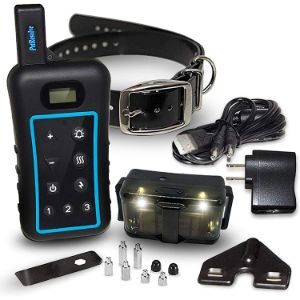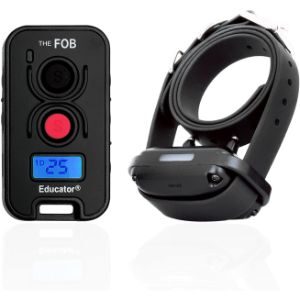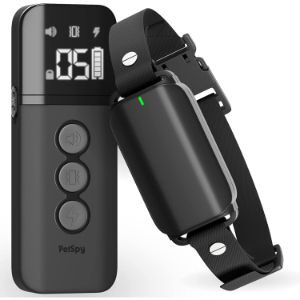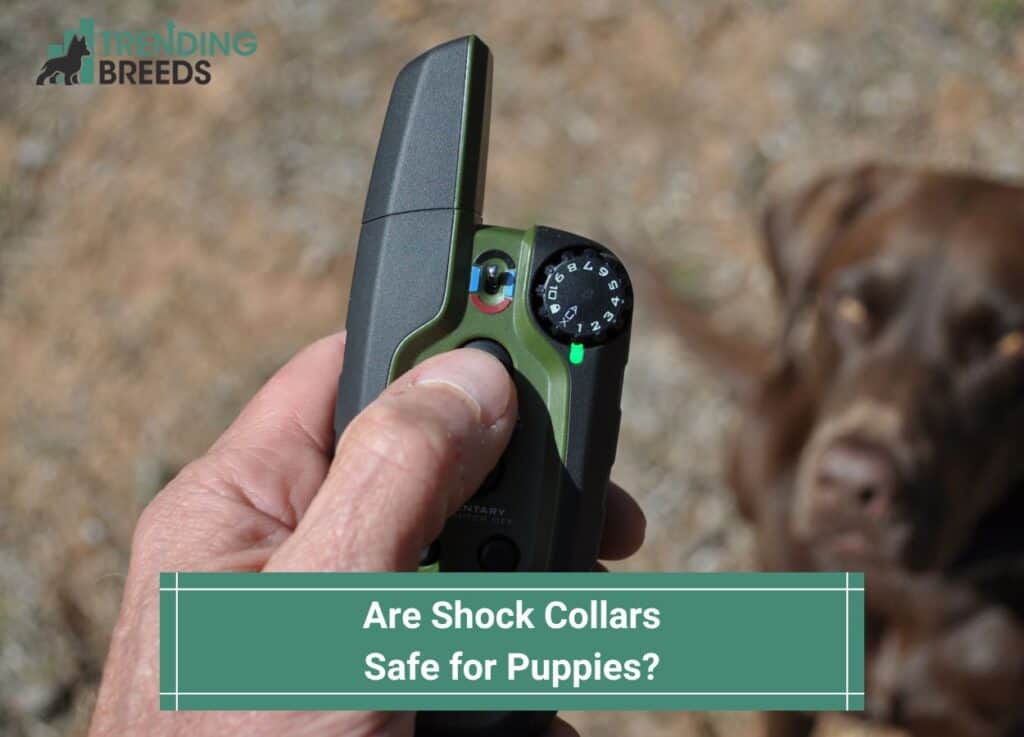
When does a puppy become a dog? How old do they have to be before you stop calling them puppies? The real answer is never! They will always be our puppies.
But we digress. When it comes to using shock collars, safety should be our number one priority for us pet parents and there are several important steps you need to take to ensure that your pup stays safe when you use shock collars to reinforce behaviors.
What we’re saying is that shock collar training for puppies is safe as long as you know the basics, and we’ll teach you all you need to know.
But before we begin, let’s remember these four things.
1. Do Not Use a Shock Collar on Pups Younger Than 6 Months
For one, the receiver’s prongs may not fit your dog, and even though some have adjustable neck sizes for dogs below 10 lbs, it’s still not advisable to use it on younger pups because they may not be mentally ready to understand the dynamics of training.
Rewarding positive behaviors may work here, so you can teach them the needed positive behaviors like basic obedience commands.
6 Months is a good puppy shock collar age for training because at this age, they enter their second “Fear Phase” where they are more responsive to aversive sensations and are quicker to make connections, which could make training them more effective.
2. The Shock Should Never Be Used for Punishment
Please etch this rule in your head. A majority of psychological problems dogs face from shock collars are from owners who use the shock to discourage unwanted behavior.
Sometimes, they use a stronger shock to do that and also do it without warning. There is a specific way to use the shock and it’s for Negative Reinforcement. And even then…
3. You Don't Have to Use the Shock Everytime
Timing is strict when it comes to using electronic collars. When using it for Negative Reinforcement, the idea is to state the command, then use the shock until your dog does the correct response.

More often than not, your dog will do the command immediately, missing your chance to press it.
If they do the correct response immediately after the verbal command or signal, give them their treat and/or praise (positive reinforcement).
If you activated the shock on previous sessions, it will eventually make them think that doing the correct behavior will keep the shock from occurring.
If you spot a noticeable delay, you can activate the shock until they do the correct response.
Some trainers who teach their dogs to come to their side when they hear the collar beep, hold the shock button until the dog actually reaches them, while others stop the shock when their dog starts running.
Ironically, the better you use the shock function, the less you’ll eventually use it.
It doesn’t mean you lose value because modern shock collars also have beep and vibration as ways to signal your dog from afar, or tracking features that help you see them in the dark.
4. Majority of All Shock Collar Issues are from Misuse
Someone who knows how to cook will use a knife and the stove, two dangerous items, to make food in a safe manner. The same can be said with shock collars.
While they don’t really cause fires or accidental cuts, shock collars can cause pressure sores and anxiety to your dog when used improperly. There are specific ways to train dogs using a shock collars.
So, How to I can I do Puppy Shock Collar Training Safely?
1. Never leave the receiver collar on your dog for more than 8 hours.
This is the leading cause of shock collar wounds called pressure sores. Some owners mistake them for burn wounds , but regardless of what people think they are, these ulcers can cause infections which need to be treated ASAP.

As soon as anything puts pressure on our skin, the tiny blood vessels under the skin get pinched. Since prongs have a small surface area, the pressure is greater, and eventually, the reduced bloodflow in the skin tissue causes the skin cells to die.
Unable to stand the pressure of the prongs, the dead skin cells are pushed off layer by layer until the skin breaks into a wound and eventually cause an infection when bacteria enter the wound.
This entire process takes a long time so it’s easily mitigated if you don’t leave the collar for too long.
If you have to keep the collar on your dog for longer than 8 hours, rotate the collar so that the receiver touches another part of their neck. Do this every 2-4 hours to give the previous spots ample time to recover.
Placing the collar on with the right tightness is also important because placing it too tight can speed up the formation of the pressure sores.
The best method is to follow the 2-Finger where you should tighten it just until you can snugly fit two fingers between the strap and your dog’s neck.
2. Always Use the Lowest "Functional" Shock Level
At some point, you likely experienced a static shock from freshly heat-dried laundry or an actual zap from a faulty wire or even a prank toy.

Shock collars are far weaker than those, a tenth of an average static shock, just enough to make the muscles under the skin to wriggle or pulse, especially at their lowest levels.
Your dog’s reaction depends on pain tolerance. Some dogs have high sensitivity levels and tend to overreact, while others will shrug it off especially when they are heavily distracted.
With so many variables to consider, the best way to approach this is to find the right balance of strength and tolerance.
Once you’ve placed the receiver on properly, set the remote to the lowest shock level, then press the shock while your dog isn’t aware of what you’re doing. If it doesn’t cause any visible reaction, raise the level to the next and try again.
If your dog shows the tiniest visible reaction, like looking up, tilting their neck, or looking mildly concerned, stay on that level and use that for training. Some trainers opted to use the level lower than that and still get results.
The idea is not to use the shock to deter them or shock them into submission.
Using a strong shock to deter them is only ever used if you’re keeping them from doing something dangerous or any extreme behaviors, such as when you’re hunting and your dog starts running towards an animal that can fight back, or shows signs of hostility and urge to attack another person or animal.
3. Do Your Research and Practice How to Use Remote Training Collars
Since you’re reading this, you’re already doing this third step, and that’s already half the battle. You don’t have to be a professional trainer to use it, and learn the precise steps.
It will seem difficult at first, but as long as you plan it out, stick to your training regime, and practice, you’ll eventually get the timing right.
The method of combining aversive training methods with reward based training (which is basically using the shock collar and a treat) is arguably the optimal way to reinforce behaviors which is why this is the only good way to use the electric shock feature.
It’s worth noting that you don’t do the “Carrot and Stick” approach, in fact, far from it. This is why it’s called Negative Reinfocement, not Punishment.
Even though prevention is better than cure, it’s still better to learn how to heal shock collar sores in case they happen. Finding the proper shock collar is also crucial because some of them address certain ways of training better than others.
4. Understand That Shock Collars are Reinforcement Tools not Teaching Tools
This ties closely with doing your homework. Teaching your dog behaviors is made by manipulating your dog’s behavior in various ways, then rewarding your dog when they perform the right actions.
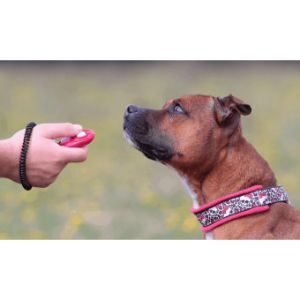
Technically, you’re reinforcing the behavior, but when you’re using the shock collar, what you’re doing is reinforcing already existing behaviors to the point where they will perform it like muscle memory.
If you use the shock to stop your dog in the middle of any unwanted behavior, they might not fully understand why they felt the shock.
If you keep doing that, your dog will start thinking that the shock can come randomly, and start feeling anxiety over that matter because they have no control over it.
By using Negatve Reinforcement via electronic training collars, you first state a command, one that your dog knows how to react to, then activate the shock.
At first, your dog will be confused, but once you stop the shock when they do the right behavior, they will eventually learn that “Doing the correction action stops the shock.” this very specific condition gives your dog a sense of control.
They know when the shock is going to trigger, they know how to stop it. If they act faster that you can press the shock button, they may eventually learn that doing the correct action stops it entirely.
5. Get Dependable Products
There’s hundreds of different collars out there and several different types of collars too. From standard remote electric collars, to automatic bark collars, and even spray collars that give a puff of citronella solution instead of using shock.
They also have a wide variety of features that will make some wonder why they add all kinds of bells and whistles to them. Even more confusing is that some budget-friendly shock collars tend to have similar features as those with a higher price tag.
It’s not an easy pick if you have no idea what you need. But if you narrow down what you’re likely going to do with the training shock collar.
Are you using it for simple yard training? Are you also planning to use this to manage your dog outdoors like dog parks or leashless walking? (If your city or district allows it.) or do you need something for advanced training like herding or hunting?
Picking one or two can narrow down the features you need.
We can say with certainty, that almost, if not all, high-quality remote training shock collars are at the $100 and above price outside of discounts.
These have higher prices not just because of brand markups, but because most collars in this price range are made for outdoor activities so they should be made with high-quality materials and have dependable features because hunting is a risky activity and an owner should be able to trust their device.
Some products in the same store will have significantly affordable prices, but even if the features are solid, some corners were definitely cut to bring the price down.
High-Quality Collars We Recommend
In case you haven’t chosen a training collar yet among the many types of collars out there, we have three handpicked shock collar for puppies, from big breeds to smaller breeds.

If you’re aiming for something else, you can at least use these as comparisons so you can make more informed decisions.






- Pros
- 3/4 Mile Remote Control Range
- Doubles as an Automatic Bark Collar
- Waterproof Collar Receiver
- Includes 2cm Metal Prongs for Long Furred Dogs
- Has Plastic Non-Conductive Prongs
- Cons
- Not For Dogs Below 15 lbs
- Does not Enter Standby Mode
We placed Pet Resolve first because its balanced and varied features make it a great choice for both beginners and professional dog trainers alike.
As long as you’re using in on a medium-size breed and above, this makes for a good puppy training shock collar since it has a wide range, high responsiveness, and 10 levels of shock and vibration, so even if you have a runner, you’ll reach them even if they gallop away from you at full speed.
It also doubles as an automatic puppy bark collar that will beep for 2 seconds when it hears and feels your pup barking, then triggers a shock if your pup doesn’t stop barking after the beep, and keep going after 8 nicks if they keep barking.
Pups are susceptible to excessive barking episodes, so if they do, you can use this to buy yourself time to find out why they have barking issues and address it. However, not all chronic barking has a trigger. Some dogs are simply born to be loud and proud.
Not only is this a decent training collar and a puppy bark collar in one, it also has LED tracking lights on its reciever and you can pair up to three receivers per remote.
The LED color will change depending on which number you paired the collar so you can tell in the dark which dog is who when you activate the strobe lights.
With a rainproof remote controller and a waterproof collar, you can expect this kit to withstand all the usual environments you and your dog will go to. The reciever has IPX7 waterproofing, enough to let your dog swim the water without suffering any water damage.
In case you have a thick or long-furred breed, you can use the 2 cm prongs so that the prongs can make consistent contact with their skin.
It also comes with plastic, non-conductive prongs to completely disable the shock and use only the beep and vibration mode.
Wether it be trying to train bad behavior off, or out hunting with your canine companion, this collar has what it takes.
- Pros
- Incredibly Compact Design fit for Smaller Dogs
- 1-100 Adjustable Shock Levels w/ Boost Button
- Bright LED Lights on the Receiver
- Three Different Training Modes
- Cons
- Not as Beginner Friendly
- Relatively Short Range
Our second device is a bit of an investment, but makes for an excellent shock collar for boston terriers, bull terriers, and other small, spunky breeds.
The wide range of correction levels give you precise control over it, literally from 1% to 100% and includes an adjustable shock boost button that delivers a shock that’s higher than your current level.
You can set the boost level from 1-60, so technically, this device has 160 levels in total. (Yes it goes past level 100).
It only has a range of 300 yards, 1/4 the range of Pet Resolve’s. Despite that, it has a powerful signal that won’t be easily blocked by obstacles, and the receiver response time is within milliseconds.
It also has different training programs and adjustments you can make, which mildly complicates its usage for the beginner and average trainer, so read the manual carefully.
This device also has remote activated LED on their receivers, but it’s positioned in such a way that dogs with long fur may block the light to some degree, reducing the brightness.
This is perfect if you want to help manage your pup’s undesirable behaviors, but still want to use the absolute lowest shock level your dog will respond to. It takes time to understand all it’s features, but even if you’re not an experienced trainer, you’ll learn in due time.
- Pros
- Budget Friendly
- 16 Levels of Stimulation
- Intuitive Button Layout and Display
- Includes Silicon Prong Caps
- Cons
- Mild Delay in Responsiveness
- Quickly Goes to Sleep Mode
Meant for more causal training for smaller breeds like the Terrier, Dachshund, Beagle; Shock collars like this have relatively weaker shock and a bit less response speed.
You do get a more intuitive button layout, that means it’s easy to understand which buttons does what, and the LCD screen shows all the basic info you need from the device.
It has a range of about 500 yards, longer than Educator, but at the cost of being slightly less responsive. If you’re keen, you may notice a mild delay between the button press and the receiver response, so time it well if you’re trying to reinforce behaviors.
The remote and receiver have a significantly longer battery life, but that’s because it goes to standby mode relatively quick. You can wake the device up by pressing a button or moving the remote around.
Keep that in mind as you may miss your timing if it does to sleep mode right before you press it. This also means you can’t use this for outdoor activities because you have to keep using the remote to keep the receiver from going to sleep mode too.
This device is likely the optimal choice if you’re looking for lower prices. Pet Resolve still has the best “Bang for Buck” while Educator has “Control”, but if you’re hesitant to invest too much, this will be perfect for you.
Conclusion For "Are Shock Collars Safe for Puppies"
Finding shock collars for puppies is one thing, and knowing how to use it is another.

Negative Reinforcement and Positive Reinforcement combined is arguably the most optimal training method out there, but this requires not just the right equipment and knowledge, but also an investment of time and effort.
You don’t have to be a professional trainer to use a shock collar. As long as you have the determination to improve you and your canine companion’s life together, training them will go a long, long way.
You can learn more about this topic by watching “Are Shock Collars For Dogs Cruel? The Truth About Dog Training With Shock Collars” down below:
Last update on 2024-04-27 at 07:05 / Affiliate links / Images from Amazon Product Advertising API

